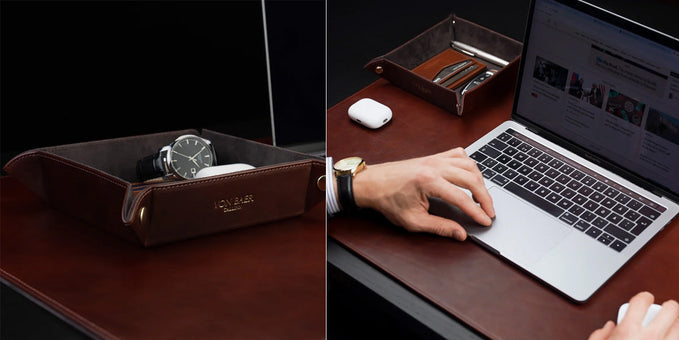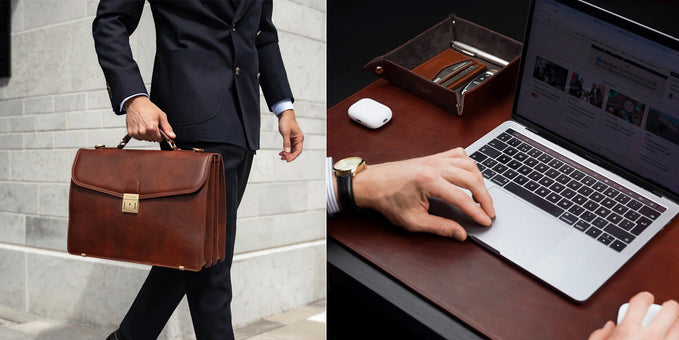How To Fix Bleach Stains on Leather

If you've got bleach on your leather item, then it will likely stain.
Follow these steps to minimize the damage now:
8 Steps To Fix Bleach Stains on Leather
Step 1: Act Quickly
- Take immediate action, speed is your friend, and the longer you wait the worse it will be.
- Take a dry, clean cloth and gently blot the stained area to absorb any extra bleach.
- Avoid vigorous rubbing or scrubbing, as this may lead to the spread of bleach.
Step 2: Examine the severity of the damage
- Once you have finished blotting the damaged area, carefully inspect the stain to assess its gravity.
- If only minor lightening of the color of the leather has occurred, there is a chance to fix the stain at your home.
- However, in cases of more substantial extensive discoloration or damage, it is advisable to seek professional assistance.
Step 3: Preparing the cleaning solution
- Get a bowl, then mix lukewarm water with a mild soap such as a gentle dish soap or pH-neutral cleaner, following the recommended dilution ratios provided by the product instructions.
- Ensure to avoid the use of bleach-based cleaners, ammonia, or harsh chemicals, as these can potentially exacerbate the damage to the leather item.
Step 4: Testing the cleaning solution
- Before you apply the cleaning solution on the stain, conduct a patch test to a very small area of the leather, like the interior section or underside.
- This test will help determine if the solution causes any discoloration or undesirable effects before proceeding further.
Step 5: Cleaning the bleach stain
- Dampen a sponge or a clean, soft cloth with the cleaning solution. Ensure that it is moist but not excessively wet.
- Carefully blot the bleach stain, starting from the outer edges and gradually moving toward the center. Refrain from vigorous scrubbing or rubbing to prevent any potential damage to the leather surface.
- Leave the blotting process until you observe the lightening of the stain. It may require multiple rounds of cleaning to get the desired outcome.
Step 6: Rinsing and drying the area
- Following the treatment of the stain, dampen a piece of cloth with water and delicately clean the area to eliminate any remaining cleaning or soap solution.
- Utilize another clean, dry cloth to blot the affected area and absorb any excess moisture.
- Leave the leather in air to dry naturally, ensuring it is kept away from direct sunlight or any heat source.
Step 7: Examine the results
- As soon as the leather has fully dried, examine the repaired area to evaluate whether the bleach stain has disappeared or faded.
- Bear in mind that the outcomes may vary based on the gravity of the bleach stain and the specific type of leather that is stained.
Step 8: Seeking Professional Assistance, if Required
- If the bleach stain remains persistent or if the damage appears extensive, it is recommended to seek the expertise of a leather restoration specialist or a professional leather cleaner.
- These professionals possess the tools and knowledge to address more severe stains and can offer treatments for your leather item.
- By diligently following these instructions, you can enhance the likelihood of successfully fixing bleach stains.
- Remember, prompt action, cleaning solutions, as well as careful handling throughout the process will aid in restoring your leather while minimizing any further damage.

Exploring the World of Leather
Leather, a coveted natural material extracted from animal hides, possesses exceptional qualities that cause it to be highly desirable. Composed of collagen fibers, it exhibits flexibility and strength.
Each type of leather, whether full-grain, suede, or patent leather, boasts unique characteristics suitable for diverse uses.
The craftsmanship inherent in leather production, enriched by time-honored techniques handed down through many generations, amplifies its allure and intrinsic value.
Need a new leather bag after a bleach stain? Shop the range of full grain leather products at Vonbaer.com.
The Chemistry Behind Bleach
Bleach, a potent chemical agent renowned for its disinfecting and stain-removing properties, encompasses different types, and each has its own reactivity and chemical composition.
When bleach interacts with various materials, including leather, chemical reactions occur, often leading to undesired outcomes.
By understanding the chemical interactions between leather and bleach, we can gain insights into the subsequent effects.
Related guides:
- Repair cat scratches on leather
- Remove water stains from leather
- Clean leather wallet & remove stains/smells
- Remove ink from leather
- Get smell out of leather
- Remove stains from leather shoes
- Clean suede leather bag
- How to reform a leather bag
- How to maintain leather bags
- Repair cracked leather
Examining the Consequences of Bleach Exposure on Leather
Direct exposure of leather to bleach wreaks havoc on the leather surfaces. Fading and discoloration are common consequences, dulling the natural vibrancy of the material.
Furthermore, bleach weakens the fibers of the leather, which compromises their integrity, causing structural damage. Surface and texture alterations also occur, transforming the tactile experience of leather.
Moreover, different kinds of leather may respond differently to bleach, necessitating consideration of their individual characteristics and properties
Indirect exposure to bleach poses risks as well. Cleaning products that contain bleach, if accidentally introduced to leather surfaces, can cause long-term harm.
Even bleach fumes, over prolonged periods, can adversely affect leather items.
Protection and Prevention Measures
Preventing any direct contact between leather and bleach is of utmost importance. It is advisable to avoid cleaning products with bleach when repairing leather items.
Employing proper cleaning methods designed specifically for leather maintenance helps protect its beauty and safeguards against unnecessary damage.
To minimize the potential harm caused by accidental bleach exposure, applying leather conditioners and sealants plays a crucial role.
These products create a protective barrier on the leather surface, acting as a shield against the effects of bleach.
Moreover, covering leather items while using bleach serves as a protective measure, effectively protecting them from any undesired contact.
Leather Maintenance and Care
Regular conditioning and cleaning routines play a pivotal role in preserving leather items. Utilizing appropriate leather cleaners, conditioners, and brushes helps maintain the material's natural splendor.
Proper handling and storage, such as shielding leather from direct sunlight and avoiding contact with sharp objects, help increase its longevity.
Steering clear of common mistakes, such as using hard cleaning agents or exposing leather to heat for a long period, prevents unnecessary damage.
Related guides:
- Wet leather
- How to clean leather bag
- How to restore faded leather bag
- How to stretch leather
- How to shrink leather
- How to soften leather
- How to wash leather
- How to fix faux leather peeling
- Leather
- What is full grain leather
- Where does leather come from
- Leather grades
- How is leather made
- Italian leather
- How to tell if leather is real
Leather and Bleach: Unique Applications
Bleached leather has remarkable applications in design and fashion.
Artists and designers embrace the transformative effect of bleach on leather, employing it as a medium for achieving captivating and unconventional aesthetics, such as bleached leather garments and sophisticated patterned accessories.
Conclusion
We hope you enjoyed our article on fixing bleach stains on leather.
If you have any questions or comments, contact us at info@vonbaer.com, or leave them in the comments.
Want to read more? Check out our Leather pages.
Related articles:
- How To Clean Mold off Leather
- How To Clean Faux Leather
- How To Repair Leather
- Leather Burning
- Best Leather Cleaners & Conditioners
- How To Get Sharpie off Leather
- How To Clean Suede
- DIY Leather Conditioner
- Wet Molding Leather
- Best Leather Oil
- How To Clean White Leather
- How To Get Oil Out of Leather
- Clean Leather Car Seats

Author: Albert Varkki
Albert Varkki is the co-founder of Von Baer. He understands leather products as a consumer, supplier, and a manufacturer, helping you with the inside knowledge you need, to choose the perfect leather product for you.
We strive for the highest editorial standards, and to only publish accurate information on our website.
Leave a Comment
Your email address will not be published.






